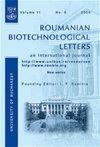Clinical and microbiological features of carious dentin in immature permanent molars
引用次数: 3
Abstract
The present study aimed to assess the dentin lesion activity in non-superficial carious lesions affecting vital immature permanent molars and to investigate possible associations between microbiological status, clinical dentin alterations, and salivary cortisol levels. Study sample consisted of a total number of 22 immature permanent molars of 13 children. After clinical estimation of lesion activity, a fine sample of deep dentin layer was removed and inoculated on bacteria tests. Salivary cortisol was assessed using an ELISA method. Most molars were diagnosed as actively carious progressing. There was a gradual increase in the bacterial counts, with higher lactobacilli (p=0.001) and mutans streptococci (p=0.045) loads in deep carious lesions, without any salivary cortisol level association. The findings of the present study discriminate between different clinical characteristics of carious lesions, supporting a conservative cavity preparation approach.未成熟恒磨牙牙本质龋病的临床及微生物学特征
本研究旨在评估影响重要的未成熟恒磨牙的非浅表性龋齿损伤的牙本质损伤活性,并探讨微生物状态、临床牙本质改变和唾液变化之间的可能联系
本文章由计算机程序翻译,如有差异,请以英文原文为准。
求助全文
约1分钟内获得全文
求助全文

 求助内容:
求助内容: 应助结果提醒方式:
应助结果提醒方式:


